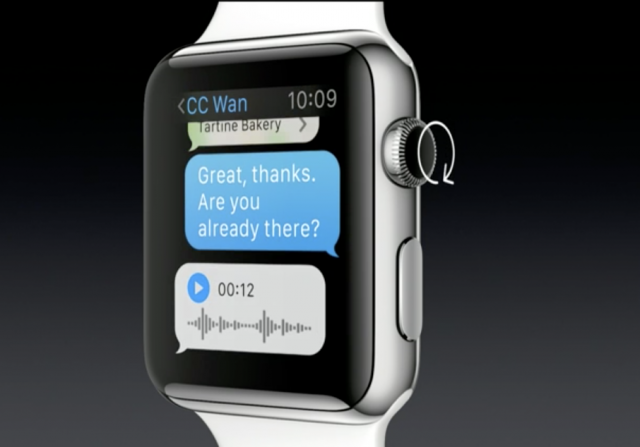On Tuesday, Apple finally unveiled the Apple Watch, the company's first dedicated wearable device.
Once rumored for an October reveal, the Watch was only recently linked to today's iPhone announcement event, and while it follows devices from the likes of Samsung, Motorola, and LG, the Watch stands out thanks to its total integration with the iPhone and iOS ecosystem. The Apple Watch comes in two different sizes—one larger and one smaller.
According to CEO Tim Cook, the Apple Watch has been in development for a considerable amount of time and required a reassessment of how users interact with devices. Not content to take the iPhone experience and simply shrink it to wrist-like proportions, the Apple Watch discards traditional gesture controls like pinch-to-zoom, since they are impractical in the tiny form factor. Instead, the primary means of interaction is with the "digital crown," the tiny dial on the watch's side. Per Cook, it lets you interact with the watch without blocking its screen (although, confusingly, a screen-obscuring swipe appears to be the most common gesture used with the Watch). A press on the "digital crown" returns you to the home screen.

The Apple Watch has what Tim Cook describes as "an amazing and rich design story." Apple design master Johnny Ive took to the stage in video form (as he often does) to talk through the device's design philosophy, which is focused around the personal nature of a wearable device versus a thing you stuff in your pocket or hide in a desk drawer. The display activates as you raise your wrist, as with other devices like the Moto 360; the crown's spin changes what it does based on the context in which it's used. It allows zooming, control adjustment, and scrolling—and it's also the home button. There's also a button that allows you to call up your contact list.
The Watch features interchangeable bands in a variety of materials, including a magnet-stuffed leather band that closes itself around your wrist and a steel bracelet with a deployment-style clasp. There are four different types of straps available; coupled with the two watch sizes, Apple has bundled the different options together into three distinct "collections."
The device's apps are new, instead of repackaged iOS apps. Ive talked about the "subtle ways to communicate" that the watch allows—sharing doodles on the watch face, or even sharing your own heartbeat with a friend. The home screen, accessed by tapping the device, reveals a "cloud" of application icons that can be panned through by swiping and zoomed with the crown. Watch faces are highly customizable and take advantage of dynamic elements; on stage, Apple Watch designer Kevin Lynch walked us through an example face that allowed the user to see their position on the surface of the Earth, or zip over to the Moon to see its phase, or even zoom out and see the state of all the remaining planets in the solar system.

Apps that deliver notifications—like the Messaging app—have a function called "Quick Board" that allows the user to pick from a list of common responses (like "Yes" and "No" and "I'll call you later" for Messages). Responses can also be dictated directly (the Watch supports interaction with Siri). Or, if you're Ars Senior Products Specialist Andrew Cunningham, you can use customized animated emoji to respond ambiguously to status requests and editorial assignments.
Apple also demoed the Watch's "Digital Touch" feature, which lets you virtually poke your Apple Watch-wearing friends (you tap on your Watch, and your friend gets a "Taptic" notification on their wrist). Once you've gotten your friend's attention, you can draw directly onto the watch face—if you're in the mood for sushi, you can draw a fish, for example, which will appear on your friend's Watch face.
The Watch features a flexible LED display topped with hard-to-scratch sapphire. The display senses not just touch, but also force, allowing the watch to distinguish between a light tap and a hard press. This enables contextually sensitive controls, letting you use single buttons to execute multiple functions depending on how hard you press. The Watch also provides tactile and auditory feedback to presses.
The Watch is powered by a custom-designed SoC, which Apple calls the S1. We'll have more details on it as soon as they're available.
Health and fitness and HealthKit are major components of the Watch, with the device leaning on your paired iPhone for GPS and other services. The fitness functionality is of particular importance to Tim Cook, who talked about it at length during the presentation. There are two apps targeted right at fitness—called, appropriately enough, "Fitness" and "Workout." Fitness monitors activity and movement, and Workout lets users set specific goals or workout types and work toward them. Apple hopes to use these apps to displace existing fitness trackers.

Charging is done with a Magsafe-style connector that automatically aligns itself with the Watch's rear face, and then inductively charges the device.
Third-party developers will be able to both integrate their apps with the Watch, and also develop Watch-specific apps using a new set of APIs called WatchKit. The on-stage demo included a full-featured Twitter application in Watch format that behaved like a Watch application should, including access to the Quick Board. Also demonstrated was a Starwood Hotels app that lets you unlock your hotel room door by waving your Watch at it, and a BMW app showing you where you left your BMW and its charge level—assuming you own an electric BMW, of course.
The Apple Watch works with the iPhone 5, 5C, 5S, 6, and 6 Plus. It starts at $349, and it will be available "early next year."
reader comments
468